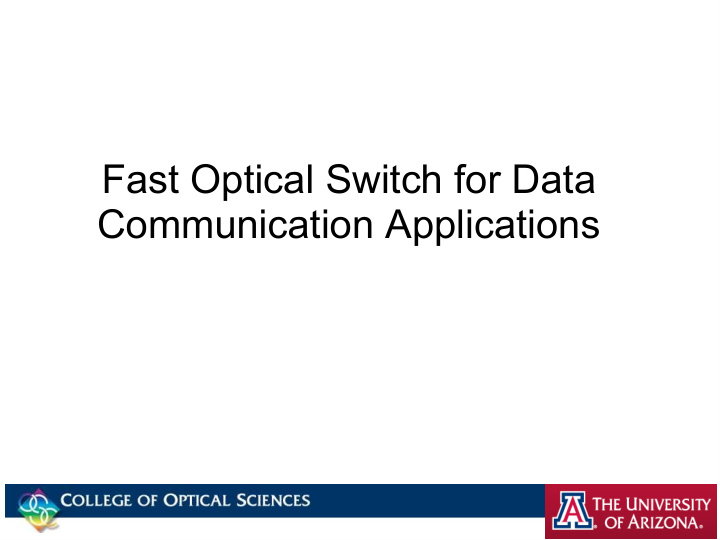



Fast Optical Switch for Data Communication Applications
- Overview - ● Data communication networks around the world use optical fibers because of the large bandwidth. ● Data routing is done by switch devices that interconnect different fibers. ● “Old way” switch converted the optical signal to electric then back to optic - Too slow when rate increases → bottle neck. - Very high energy consumption.
- Optical switch - Function: – Directly connects any N input fibers to N output fibers (NxN) – Rate agnostic Usage: – Data centers – ROADM – Network aggregation
- Market Drivers - ● Exponential increase of the data traffic due to cloud computing, mobile devices (tablets, smartphones), social networking.
- Optical switch market share -
- Current technology - ● O-MEMS based ● Mirrors on gimbals mount ● Mirror reoriented to redirect the beam
- Current technology - CONS PROS ● Custom made element ● Large number of port (320) ● Millisecond response time ● Low insertion loss (3db) ● Sensitive to vibration ● $300-$700 per port ● Sensitive to input energy ● Sensitive to failure ● Hinge failure (small MTBF) ● Power consumption (45W) ● $300-$700 per port
-Our Approach- O-MEMS → DMD - 12 μs switching time (vs 25 ms) - Bistable (reduced power) - Mass produced (cheap) - Highly reliable ( 10 12 flips) - Large number of elements (1024x720) - Used in projectors - Television - Medical/automotive display How do you steer a beam with a binary device?
-Our Approach II- Reflection → Diffraction Holograms: - Binary pattern - Calculated by iterative Fourier transform - Diffract light in deterministic way Diffraction Printed hologram
-Our Approach III- Reflection → Diffraction Hologram DMD Diffraction - Robust (distributed information) - Scalable (thousand of ports) - Handle beam power (distributed energy) - True non-blocking (all ports accessible) - Addition/division functions (ROADM)
-Our Approach III- No exotic parts s Fibers out n e L DMD Fibers in
-Characterization- Non-blocking ✓ All ports accessible 9x9 visible / 7x7 IR Loss map per port DMD sectioning
-Characterization II- Testbed insertion & video transmission ✓ Network simulator Switch
- Tech Comparison- Port Vendor Technology Loss speed Power Reliability count Calient 3D MEMS High Low ms 45 W Low CrossFiber 3D MEMS Low (1x8) Low ms 1W Low Polatis Micro-actuatio Moderate Low ms 128W Good DirectLight n DMD Nistica* wavelength High Low μs 1W High switch High DMD UA High μs 1W High Addressed in next Hologram phase * The Nistica product is a wavelength switch (not space) using the DMD
Loss budget 50% Fiber injection – Analysis of the injection condition – Solution found (replacing lens) 50% Diffraction – Binary amplitude grating 10% efficiency – 8 level phase grating 90% efficiency – Require a piston DMD
- Competitive Advantage - - Commercial Appeal - Disruptive technology ! - Faster (100x) - Scalable (1,000s of ports) - Robust (10 12 mirror cycles) - Cheaper per port (<$100) - Low power consumption (1 Watt)
- Commercial significance - ● Bill-Of-Material → manufacturing cost <$100/port ● Preliminary Data Sheets ● Assessment of Packaging and Integration Options ● Interaction with - Texas Instrument - Fujitsu - Nistica - UCSD
Next steps Metrics Current Phase 1 Phase 2 Ports count 7x7 30x30 128x128 OSNR [db] >8 >10 >100 Insertion loss [db] 36 16 5 Homogeneity [db] 5 3 1 Repeatability [db] N.A. 0.5 0.1 Cross talk [db] <-73 <-100 <-100 Speed [μs] 50 12 5
Recommend
More recommend